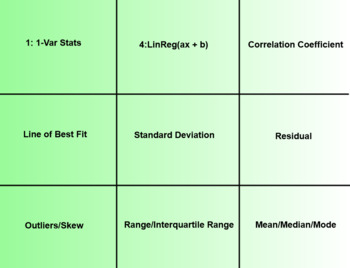Unit 1-Statistics (Math 1)
Secondary Math Materials
35 Followers
Grade Levels
6th - 12th
Subjects
Resource Type
Standards
CCSSHSS-ID.A.1
CCSSHSS-ID.A.2
CCSSHSS-ID.A.3
CCSSHSS-ID.B.6
CCSSHSS-ID.B.6a
Formats Included
- Zip
Pages
N/A
Secondary Math Materials
35 Followers
Description
This is the first Unit of the eight Units that I cover in Math 1. This unit is broken up in to six different lessons that are listed below. Each lesson includes a SMART Notebook presentation, a student note-taking guide, and an answer key. Also included in this unit are student flashcards, a test outline, and a 25 question multiple choice test.
Unit 1: Statistics
Lesson 1: Mean Median Mode Range Outliers and Skew
Lesson 2: Box and Whisker Plots
Lesson 3: Standard Deviation
Lesson 4: Correlation vs Causation
Lesson 5: Linear Regression and the Correlation Coefficient
Lesson 6: Residuals
Flashcards
Test Outline
Test
Check back later to get Units 2 thru 8!
Unit 1: Statistics
Unit 2: Linear Functions
Unit 3: Functions and Slope
Unit 4: Geometry
Unit 5: Systems of Equations and Inequalities
Unit 6: Exponential Functions
Unit 7: Operations of Polynomials
Unit 8: Quadratic Functions
Unit 1: Statistics
Lesson 1: Mean Median Mode Range Outliers and Skew
Lesson 2: Box and Whisker Plots
Lesson 3: Standard Deviation
Lesson 4: Correlation vs Causation
Lesson 5: Linear Regression and the Correlation Coefficient
Lesson 6: Residuals
Flashcards
Test Outline
Test
Check back later to get Units 2 thru 8!
Unit 1: Statistics
Unit 2: Linear Functions
Unit 3: Functions and Slope
Unit 4: Geometry
Unit 5: Systems of Equations and Inequalities
Unit 6: Exponential Functions
Unit 7: Operations of Polynomials
Unit 8: Quadratic Functions
Total Pages
N/A
Answer Key
Included
Teaching Duration
2 Weeks
Report this resource to TPT
Reported resources will be reviewed by our team. Report this resource to let us know if this resource violates TPT’s content guidelines.
Standards
to see state-specific standards (only available in the US).
CCSSHSS-ID.A.1
Represent data with plots on the real number line (dot plots, histograms, and box plots).
CCSSHSS-ID.A.2
Use statistics appropriate to the shape of the data distribution to compare center (median, mean) and spread (interquartile range, standard deviation) of two or more different data sets.
CCSSHSS-ID.A.3
Interpret differences in shape, center, and spread in the context of the data sets, accounting for possible effects of extreme data points (outliers).
CCSSHSS-ID.B.6
Represent data on two quantitative variables on a scatter plot, and describe how the variables are related.
CCSSHSS-ID.B.6a
Fit a function to the data; use functions fitted to data to solve problems in the context of the data.





